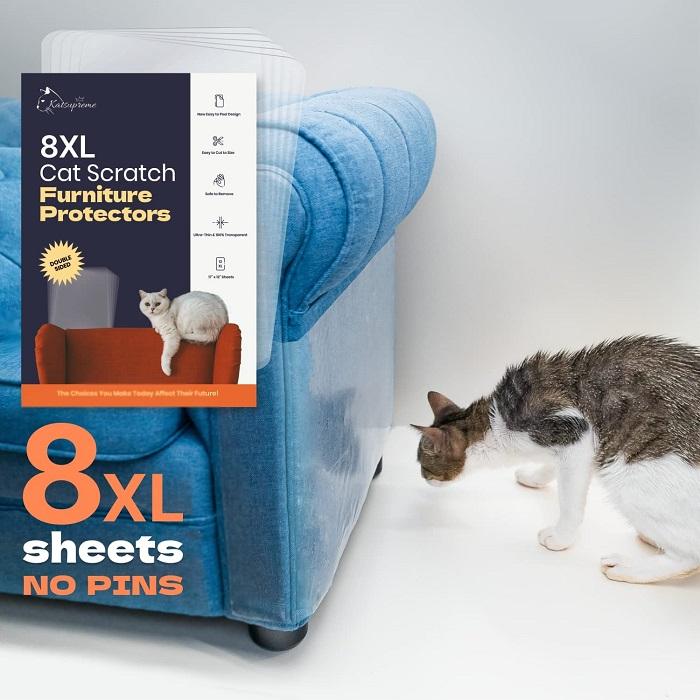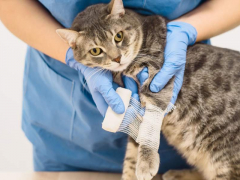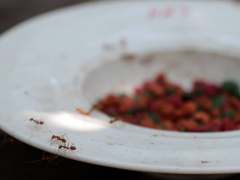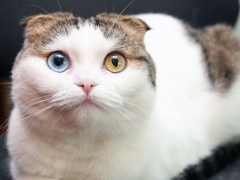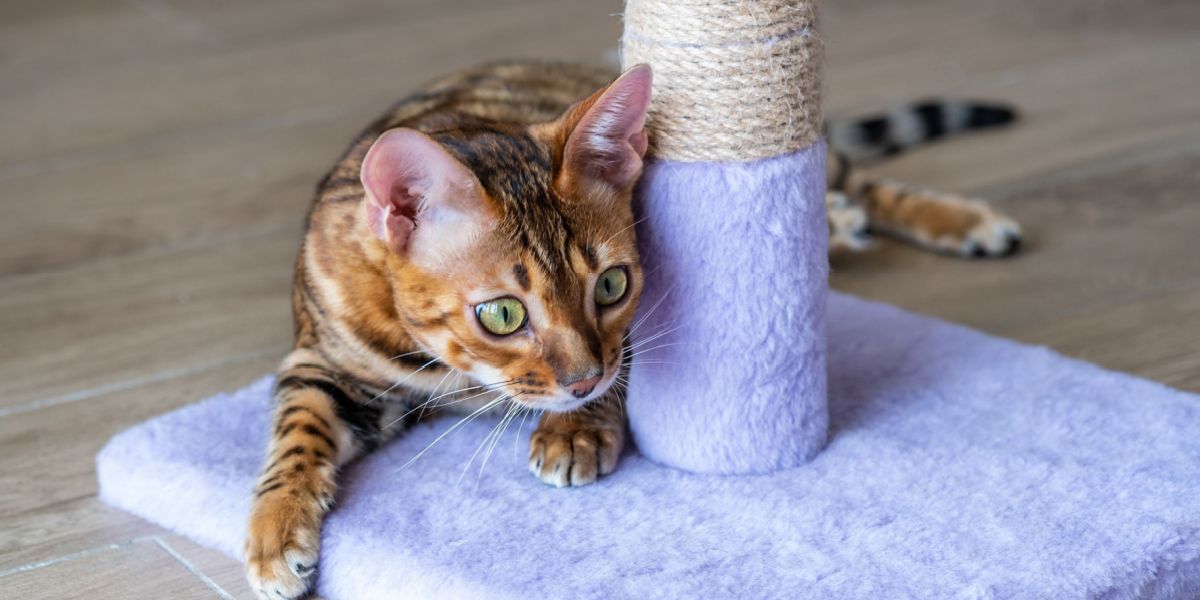
The sound of cat claws catching on soft furnishings like the sofa or dining chairs can set our heart sinking. Some cats have a real love of shredding curtains, chairs, or even carpets when the mood strikes them.
Scratching can be an infuriating behavior for us to deal with as cat owners, but it is actually a completely normal cat behavior that all cats participate in to some extent. Cats can enjoy scratching on both horizontal and vertical surfaces depending on their preference, or sometimes both.
Why Do Cats Scratch?
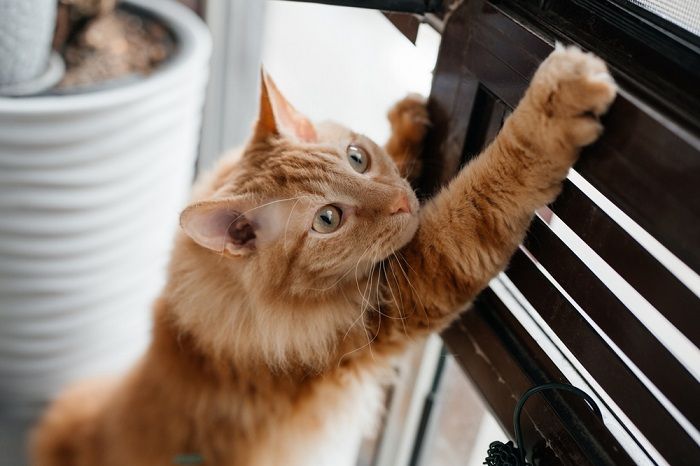
Cats engage in scratching to communicate to other cats, for exercise, and to keep their nails healthy.
Scratching in cats is a form of communication. They use scratching to mark their territory, both inside and outside of the home. When cats scratch, they leave visible scratch marks. For this reason, scratch marks are often in prominent areas. This is often in a high-traffic room in the home, or close to the cat door to ward off potential intruders.
Scratching also releases a powerful scent onto the item being scratched that tells other cats in the neighborhood whose territory they are in. This helps cats to keep to their own designated areas and reduce fights. The scent, though potent, does need to be topped up regularly so this is another reason cats repeatedly go back to the same spot to scratch or mark.
Also Read: The 10 Best Scratching Posts In 2022
Cats also enjoy scratching—it helps to loosen up all their muscles and feels good. You’ll often notice cats enjoy a good scratch when they wake up from a nap or after breakfast to help limber them up for the day’s activities.
Scratching helps to keep claws sharp and to remove dead sections of nails. Nails are constantly growing and shedding, so scratching helps remove the portions that are no longer attached to the nail bed anymore. Do not be alarmed if you find flakes of nails around the scratching post, it’s not that the surface is too hard or damaging, it’s a sign the post is performing well at its duties.
Also Read: Correcting Unwanted Scratching Behavior
How Do You Get Your Cat To Use A Scratching Post?
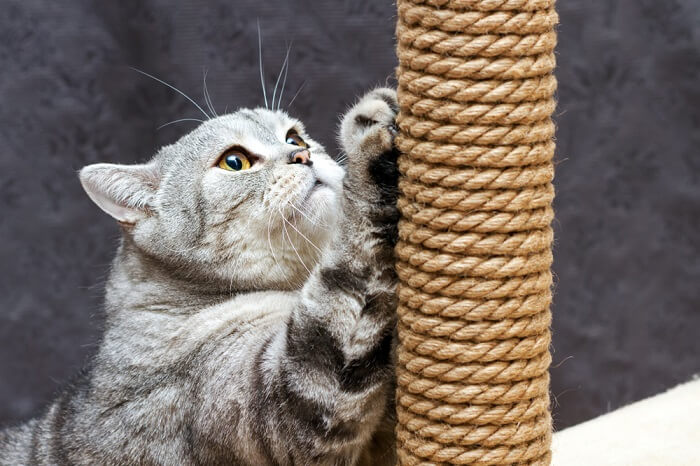
With patience and persistence, you can redirect your cat’s scratching to a designated scratching post.
This process takes time, patience, and an acceptance that you may still have a few “accidents” during training. The goal is to redirect the scratching behavior from your piece of furniture onto a designated cat scratch post.
Also Read: Why Do Cats Scratch Furniture And Carpets?
1. Choosing The Right Scratching Post
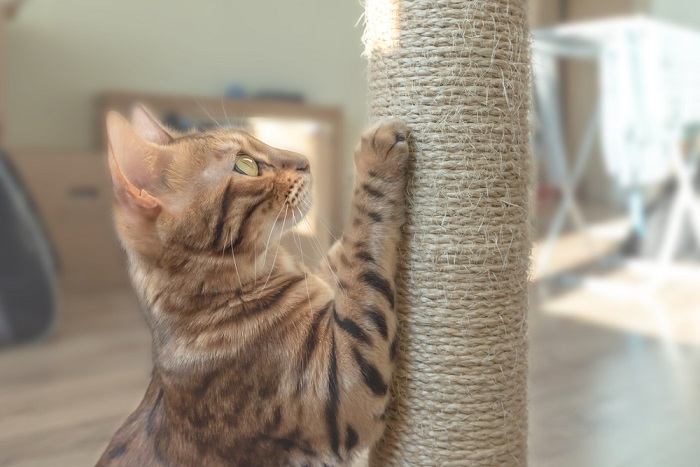
In general, a scratching post should be at least twice as tall as your cat.
It’s very important for the scratching post you choose to be sturdy. In the wild cats would scratch on stable surfaces like trees, so need something similarly nonmobile in the home. The scratching post you choose should be able to be scratched without being knocked over.
A cat will not use a scratching post if it poses a risk of injury to themselves. Light or short scratch posts are often ignored, so in this case, bigger is actually better!
The scratching post needs to be tall enough for vertical scratching, as cats love to stretch out their front paws and dig their claws into their scratch surface. The scratch post should be at least twice as tall as your cat as a general guide.
Also Read: Why Do Cats Arch Their Backs? Top 8 Reasons
2. Scratching Post Positioning
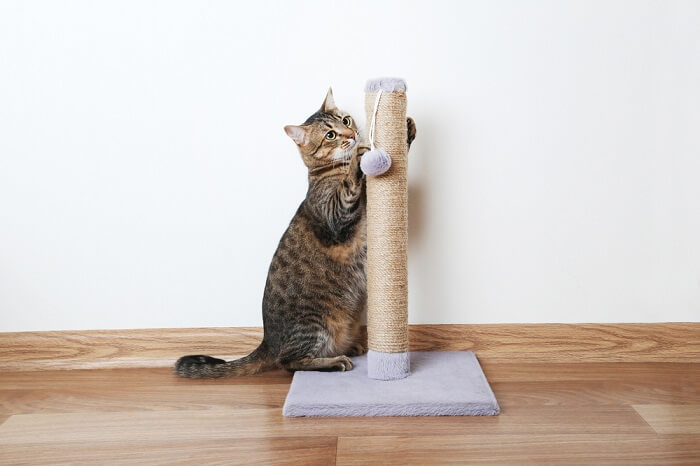
At first, place the post close to the thing you don’t want them to scratch (for instance, the couch).
It sounds obvious, but putting the scratching post in front of the piece of furniture you are trying to preserve can be really helpful. It gives an automatic alternative that should be preferable to your cat. Over time, you can train your cat to use the post and not your furnishings.
As a long-term goal, once scratching has moved onto the post exclusively you can gradually (over a few weeks to months) move the scratching post to a more convenient location in the home if needed.
Also Read: Check Your Knowledge: Scratching Post Placement
3. Number Of Scratching Posts
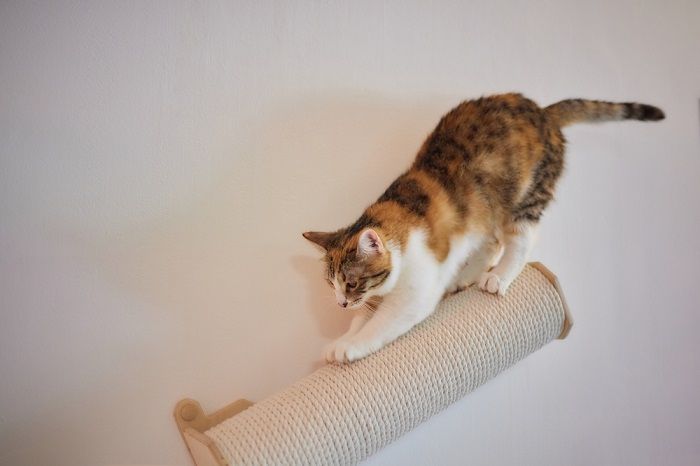
The more scratching posts you have the better, but at a minimum, each cat should have their own.
Each cat in your home will need their own scratching post. Cats do not enjoy sharing, and it’s confusing to have two sets of scents on one post. Keep each scratching post in a different location in the home.
When looking to buy a new scratch post, remember that the best scratching posts are strong, durable, and made up of different materials, such as carpet, sisal rope, or corrugated cardboard. Different materials and textures help simulate the variety cats would find outside and encourage their use.
4. Natural Supplements
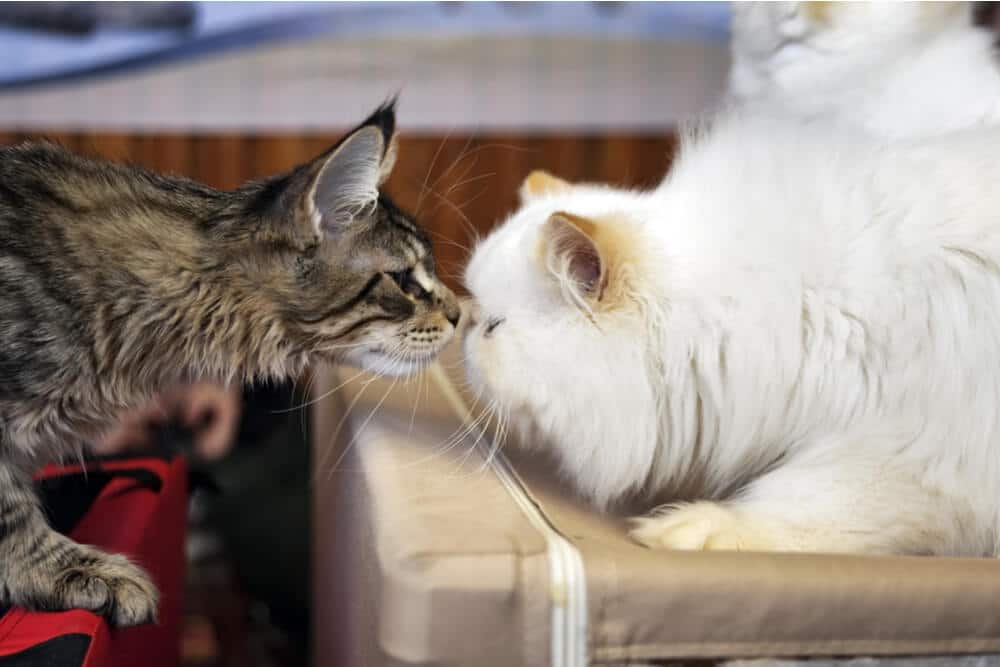
Pheromones or catnip can help attract your cat to the new scratching post.
Pheromone diffusers like Feliway, Feliway Friends, or Feliscratch are all helpful in training your cat to use a scratching post. Feliway contains natural pheromones released by the mother when kittens are young, and help cats of any age to relax and feel more secure in their home. This in turn helps to reduce scratching and marking.
Feliscratch is a topical solution that is applied to scratch posts to encourage cats to use the scratching post. When cats scratch, they release a pheromone to mark their territory, and Feliscratch contains a similar pheromone.
Also Read: What Are Cat Pheromones And Do They Really Work?
Cats smell the pheromone and it helps encourage them to keep marking that spot rather than go back to old places. Only use Feliscratch on your scratching posts or scratching pad (it can stain your furniture), and apply the solution near the top of the post.
Catnip is an older technique but can still be helpful if your cat enjoys catnip. Placing catnip on or around the cat scratching post can encourage your cat to be interested in, play near, or even scratch on the post once the catnip is in their system.
Also Read: The 6 Best Catnip Treats
5. Nail Trimming
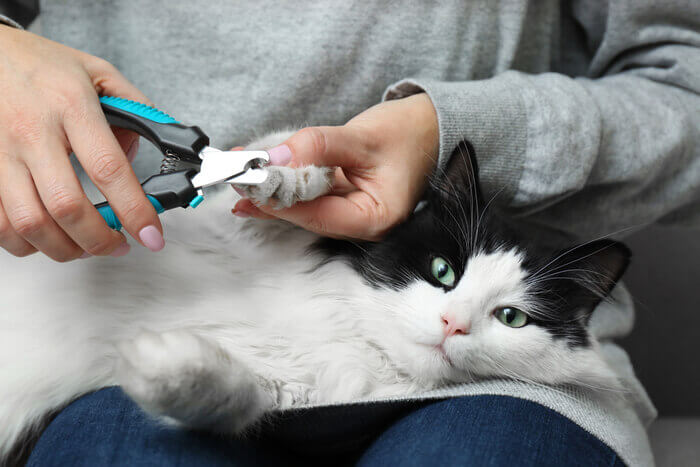
Trim your cat’s nails short to help decrease damage caused by scratching in the wrong places.
Trimming your cat’s nails short can help protect your furniture while actively trying to redirect the behavior. Nail trimming can reduce damage in the short term. Ask your veterinarian for a demonstration if you are unsure how much nail to clip, as taking too much can cause your cat pain and the nail to bleed. You can also bring your cat in to the vet clinic or a to a pet groomer if you are not comfortable trimming the nails yourself.
Beware, cats are very good at sharpening their claws, so nail trimming not a permanent fix. Cats also need their claws for climbing, protecting themselves in fights, and grooming so this tip is better suited for indoor-only cats while training is in progress.
Also Read: How to Safely Trim Cat Nails – A Step by Step Guide
6. Protect Furniture
When cats scratch, they enjoy seeing their “artwork” as the end result. Using barriers such as Katsupreme scratching tape (available on Amazon) discourages cats from scratching by reducing the appeal of scratching in that area. Katsupreme scratching tape has the added benefit of being transparent, so fits in with most home decors.
If you are looking for a budget-friendly option, try covering the side of the sofa with a thick blanket. You may need to change this regularly.
Also Read: KatSupreme Scratch Deterrent Tape Review
Even if Your Cat Is Declawed, They Still Have the Ingrained Desire to Scratch

Declawing is not a recommended solution to scratching issues in the home.
Declawing is the surgical removal of the claws and nail beds of cats. This is a nonreversible, permanent procedure that is illegal in most European countries. Cats need their claws to protect themselves if going outside and for normal movements such as running, jumping, and grooming.
Even if your cat is declawed, they still have the ingrained desire to scratch and release scent to mark their home so damage can occur over time. We do not recommend declawing as a solution to scratching issues in your home.
Also Read: The 5 Best Cat Scratch Deterrents
Summary

Any cat of any age can learn to use a scratching post.
It’s easier to train your cat to use a scratching post when they are younger; older cats can have trouble relearning the scratching behavior once established. However, it is still very possible to train any cat regardless of age to use a scratching post, and the results can be very rewarding.
If you have tried many of the suggestions mentioned above, and your cat is still scratching furniture, it may be time to reach out for professional help. A veterinary behaviorist would be the perfect person to help you with this issue.
Also Read: Why Does My Cat Scratch and Dig Around His Food?
Frequently Asked Questions
Do cats scratch when they are happy?
Yes, cats scratch to communicate with their owners or to draw attention to themselves if they want to play with you. They can also scratch when stressed or excited, so reading their body language as a whole can help you pick out their emotions.
How can I get my cat to stop scratching?
Scratching is normal behavior for cats, so you need to focus on redirecting the scratching behavior onto cat-friendly items like scratching posts and away from your shredded sofa. Choosing the right scratching post, and using pheromone sprays, Katsupreme scratching tape, or blankets to cover furniture, can be helpful.
What makes a good scratching post?
A strong, sturdy structure with different materials such as sisal rope or corrugated cardboard to engage your cat’s interest. Some scratch posts have cat toys such as mice or rope, and this encourages your cat to play and interact with the tower.
